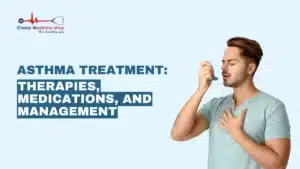In medical terms, shortness of breath is known as dyspnoea and it is a complex symptom that arises due to physical impairment and increases the possibility of threatened homeostasis. Most often, shortness of breath occurs due to cardiovascular disease or respiratory disease. But, it can also be a result of metabolic derangement, neuromuscular disorders, or any psychogenic problem.
Afferent signals, efferent signals, and central information processing are the three components that contribute to the occurrence of shortness of breath. The central processing in the brain compares the efferent signals and afferent signals and when the mismatch occurs between the two signals, shortness of breath occurs.
1. Asthma
Asthma is a long term disease of the lungs that interferes with normal breathing by narrowing the airways both within and leading to the lungs. The airways are the breathing tubes that carry air in and out of the lungs. When the airways become narrowed the amount of carbon dioxide leaving the body and the amount of oxygen entering the body are both restricted.
Shortness of breath is the most common symptom of asthma and other symptoms include wheezing, chest tightness, and cough. In patients having asthma, as the air tries to move through the narrowed airways a patient hears a wheezing sound. A cough is also common and usually, it occurs at night or early in the morning. During an asthma attack, an individual experience severe symptoms. During the attack, he or she may breathe so fast that they find difficulty in talking and other symptoms such as coughing, wheezing, and chest tightness makes a person feel anxious and scares. As a result, the breathing becomes more difficult.
The airways get irritated and tighten very easily by a variety of things such as allergies, respiratory infections, and various irritants. Numerous studies suggest that if you have allergies, you are more likely to cause asthma. Some common allergens include dust, weeds, trees, and cockroach droppings. Respiratory infections are also the common cause of the occurrence of asthma. Other irritants that can cause asthma include dust, paint, perfumes and many more.
Also Read: Shortness Of Breath Require Your Attention
2. Chronic obstructive pulmonary disease
A chronic obstructive pulmonary disease is a disease which makes it difficult to empty air out of the lungs. As this difficulty in emptying the air out of the lungs makes an individual work harder, results in shortness of breath.
A chronic obstructive pulmonary disease is a medical term used for conditions such as chronic bronchitis and emphysema. Chronic bronchitis is defined as a condition which is characterized by the increased swelling and an increased production of mucus in the airways. Due to swelling and extra mucus, airway obstruction occurs in chronic bronchitis. In emphysema, the walls of some of the alveoli have damaged and this causes the alveoli to lose their stretchiness and trap air. This makes it difficult to push the air out of the lungs and hence, lungs do not empty efficiently.
A chronic obstructive pulmonary disease can be caused by various factors but cigarette smoking is the most common of all the factors. Certain environmental and genetic factors can also play a role in the development of this disorder such as heavy exposure to dust, chemicals, and indoor and outdoor air pollution can also contribute to the development of a chronic obstructive pulmonary disease.
3. Pneumonia
Pneumonia is a type of lung infection that involves lung alveoli and this infection can be caused by bacteria, virus, and fungi. Pneumonia typically occurs after an exposure to the bacteria or virus in the environment or is passed on from one person to another. The lungs are susceptible to infections as they interact with the outside environment and are exposed to air every day which may contain infectious or toxic agents.
Also, the lungs are connected to the upper airways and therefore, they are frequently exposed to a small amount of saliva and oral secretions that contain bacterias. Although this disease can occur in anyone, individuals whose immune system are deficient are at increased risk of developing this disease. Also, diseases like human immunodeficiency virus, diabetes, renal failure, and cancer are the risk factors for pneumonia. Therefore, infants and the elderly are more vulnerable to this disease.
4. Hyperventilation
Hyperventilation is a rare condition and it occurs as a response to fear and stress. It is characterized by the rapid mouth breathing and sensation of dryness in the mouth. These are the clinical features of this disease and other symptoms of hyperventilation include a sensation of dizziness, unconsciousness, seizures and certain diseases that can cause vestibular dysfunction.
The excessive breathing causes hypocapnia, respiratory alkalosis, and a sequence of psychological changes are responsible for most of the symptoms that occur in this disease. Sometimes musculoskeletal pains and spasms can also be experiences, primarily in the chest, and may also occur in a variety of locations, such as the head and back. Usually, the chest pain is variable in nature, lasting from minutes to hours.
5. Myocardial Ischemia
Myocardial ischemia is a condition which occurs when the need for oxygen in any significant zone of myocardial is not me by the coronary blood flow. Normally, the myocardial oxygen demand is met by the coronary blood flow and the main determinants of myocardial oxygen demand are heart rate, wall tension, and and it depends on aortic pressure, left ventricular volume and myocardial fibril length.
Myocardial ischemia is also known as cardiac ischemia and it damages the heart muscle which in turn affects the functioning of the heart. The damage to the heart reduces the efficiency of the heart to pump. Myocardial ischemia is characterized by the symptoms like irregular heartbeat, sweating, nausea, vomiting, shortness of breath and neck and jaw pain














